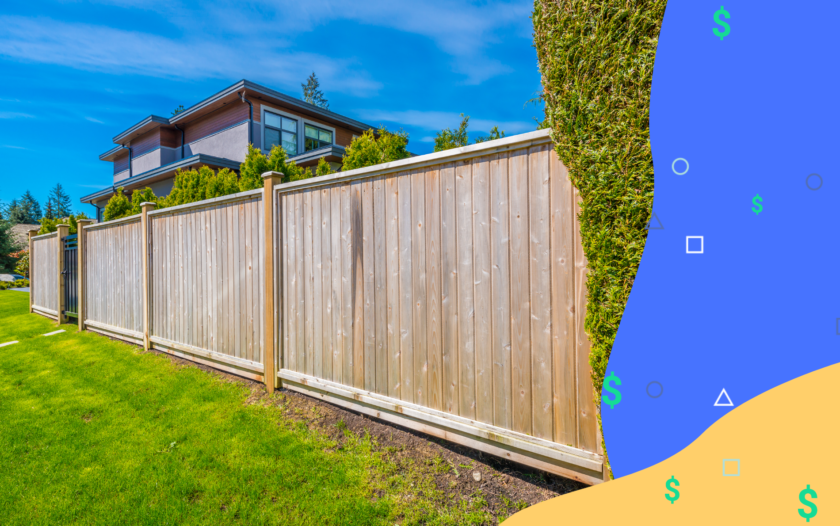Fence Financing – Compare Loan Options
About
Trevor Mahoney is a financial services writer and content creator based out of Los Angeles, California. He holds a Bachelors of Science in Finance from Santa Clara University. In his free time, he enjoys hiking and lounging on the beach.
About Trevor
Trevor Mahoney is a financial services writer and content creator based out of Los Angeles, California. He holds a Bachelors of Science in Finance from Santa Clara University. In his free time, he enjoys hiking and lounging on the beach.
Read full bio
At a Glance
Adding a lovely fence to your property can provide several benefits ranging from an added layer of security to pure aesthetics. Installing a fence is no cheap feat, though, and the cost can easily get into the thousands depending on the type of fence, the length, and other factors.
Given this potentially high cost, it’s completely reasonable to assume that one may not be able to afford the expense out of pocket. Fortunately, there are fence financing options available. Ranging from simple loans to more complex home equity lines of credit, you can quickly learn about the different options and what may be best for you with this comprehensive guide.
In this article, learn more about:
Starting with the basics, a fence finance loan is like any other type of loan in that you borrow money from a lender to pay for the total cost of the fence installation. After borrowing the money, you begin monthly repayments that encompass the portion of the principal due that month, interest, and any potential fees.
To qualify for such a loan, you will need to provide both personal and financial information, such as your address and all streams of income. Depending on the type of lender, you may receive the funds in as little as 24 hours.
Home improvement loans are an efficient and affordable option for all of your home projects. Compare loan options to finance a fence with home improvement loan.
Find and compare the best loan options.
Use the filters below to refine your search

Sorry, we didn’t find any options that meet your requirements. Please try modifying your preferences.
Congratulations! You’re close to seeing your offers!
Please take a second to review the details you shared earlier
Sorry, we didn’t find any options that meet your requirements. Please try modifying your preferences.
What are some fence loan options?
Fencing financing can look different depending on the type of financing a person chooses. Given these different options, it’s important to break down each to ensure you are making the best choice:
1. Personal loans
One of the more basic options of financing for a fence is taking on a personal loan. These loans can be used for virtually any purpose, making them excellent for a more unusual expense such as fence installation. Amounts that can be borrowed range from under $100 all the way up to $100,000, depending on the lender.
When applying for a personal loan for fence financing, your credit score will be considered as one of the factors that help determine the APR you are offered. This annual percentage rate can vary from 6% to 36%, on average. An added benefit of personal loans is that they are typically unsecured, meaning no form of collateral is needed to take out the loan.
2. Home equity loans
Home equity loans are a more unique type of fencing financing than the options on this list. They essentially work as a second mortgage, allowing you to borrow money against the equity that you have built in your home. These are more dangerous loans, however, as your home serves as collateral if you can’t meet payments.
On the other hand, home equity loans usually offer a lower interest rate than other unsecured loans. The minimum borrowing amount for a home equity loan is around $10,000, meaning this option should be reserved for a fence loan of a larger amount.
3. Home equity lines of credit (HELOC)
Like a home equity loan, a home equity line of credit (HELOC) allows you to borrow money against your home’s equity. However, the money is available to you as a revolving line of credit, meaning you only borrow what you need and repay that amount. This option is best for those who need ongoing fencing financing options, such as a person with multiple properties.
Related: Home Equity Loans vs. HELOC
What credit score do I need for fence loans?
To receive a favorable interest rate on a fence loan, it’s recommended that you have a credit score of at least 680. No credit check fence financing is extremely rare, and even if you can find a lender willing not to run a check the interest rate will likely be sky-high.
Pros and cons of fence financing
All financing options, no matter how great, have their own pros and cons. Here are some that you need to know when looking at how to finance a fence:
| Pros | Cons |
|---|---|
|
|
|
|
|
|
|
|
Other fence financing options
It may be the case that none of the above options for how to finance a fence work for you personally or monetarily. If this is the case, consider some of the following fence installation financing as alternative options:
1. Fence financing options from retailers
The retailer who is providing you with the fence itself may also offer financing. In some cases they may offer 0% interest promotions on financing, such as if you use the retailer’s credit card to make the purchase.
For example, Lowe’s has financing options tied to the Lowe’s Advantage Card. They have special six-month financing with 0% interest for six months, and 84-month fixed-pay financing with low 9.99% fixed interest.
Home Depot financing options include the Home Depot Consumer Credit Card (0% interest for six months, or with special financing you may even get up to 24 months interest-free) and the Project Loan program that offers APR as low as 7.42%.
Retailer financing isn’t always the best option, but at the very least, it’s worth inquiring to see whether they have financing and what it looks like so that you may compare their offer with other options.
2. Consider credit cards
For some with a strong history of responsible usage of credit cards, using one to purchase a fence can be an excellent strategy. This can be especially beneficial if you have a rewards credit card that will allow you to earn benefits like cash back or travel rewards.
Additionally, you may be able to qualify for a 0% intro APR credit card and avoid paying interest during the promotional period (typically 12 to 24 months), which can help save you money on interest and even earn you extra rewards. Many new credit cards also offer sign-up bonuses if you spend a certain amount in the first few months of account opening, so you may qualify for that depending on the timing of your purchase.
However, if you don’t have a 0% intro APR card and/or aren’t able to pay off the balance completely in one billing cycle, you’ll be paying a higher interest rate on the outstanding balance. This can quickly increase your debt and be difficult to repay.
Using a credit card should only be a leading option assuming you have a 0% introductory APR, you’re attempting to reach a spending bonus amount or are earning high rewards, or you’re just confident you can have the full balance paid off within one cycle.
3. Budget in advance and use cash
Ask yourself if the fence you want to install really needs to be installed urgently. If the answer is no, consider putting money away each month until you reach the amount that the fence will cost. This will require no extra interest payments and once you pay, your obligation is complete. While this may be a difficult strategy for larger fence projects, it is an excellent option for smaller ones.
Can you get fence financing with bad credit?
Regardless if you have good or bad credit, you can likely qualify for fence financing. However, if you have bad credit, your options may be more limited. Your best financing option with bad credit would likely be a personal loan, which you can qualify for with some lenders with a credit score of 550 or above (though most lenders prefer at least 620).
Know that if you have bad credit, your chances of getting approved are lower. Additionally, your approval amount may be lower and your interest rate can be much higher. To increase your chances of getting approved and improve your interest rate, take steps to raise your credit score.
FAQs
The question of whether you can get a loan for a fence is extremely common and the answer is yes. Personal loans are a very common type of fence financing. A fence company that finances its own installations may also exist. A home equity loan is another type of fencing loan that exists but is riskier because it is a secured loan with your home as collateral. However, there are many options when it comes to financing a fence.
At the end of the day, the decision between saving money for a fence installation or borrowing money is a person-to-person decision. If you are extremely confident you can fully pay the loan off without a detrimental impact to your finances, and you want the fence now, borrowing money can be a good strategy. However, if you don’t have the best credit or simply don’t need the fence now, saving up and paying it out of pocket is also an excellent choice. Consider your personal and financial situation before making any type of borrowing decision.
Installing a fence is no cheap task. In fact, the average fence installation cost at Home Depot, a leading company in the field, was $4,600 in recent years. This amount can range from $1,000-$100,000 depending on materials used and the complexity of the task, among other factors. Given this, many people may not be able to afford the expense up-front and out-of-pocket.
First, determine how many linear feet of fencing you’re going to need. Then, think about what materials you want to use. Types of materials you can use for fencing and cost can vary significantly. (For example, a new fence can range from $1 to $50 or more per linear foot.)Once you have measurements and an idea of the cost of materials, you should be able to estimate the cost of your fence.
If you’re considering hiring a professional to complete the project, have them come out for an estimate. It’s a good idea to get estimates from at least three professionals. Then, you can compare those costs with the cost of doing it yourself, and decide which is more affordable.
Financing for fence repairs or replacement is typically available through various channels. Homeowners can explore options such as personal loans, home equity lines of credit (HELOCs), or credit cards to cover these expenses. Additionally, some fencing companies may offer financing plans to help clients spread the cost over time. Availability and terms can vary, so it’s advisable to research local lenders and consult with fencing professionals to determine the best financing solution for your specific needs.
The tax implications of financing a fence depend on the type of financing used and the specific tax regulations where you live. In many cases, the interest paid on a personal loan or a home equity loan used for fence financing may be tax-deductible if the fence is considered a capital improvement to your property. However, it’s essential to consult with a tax professional or accountant to determine how these deductions apply to your situation. Using a credit card for financing typically doesn’t offer tax benefits.
Financing a fence through a contractor and directly through a lender each has its own set of pros and cons. Financing through a contractor can be convenient, with potential for bundled deals, but it might limit your loan options and result in higher interest rates. Direct financing through a lender offers more choice, potentially lower rates, and greater transparency. However, it may require more effort in finding the right lender and negotiating terms. Ultimately, the choice depends on your specific circumstances, so consider factors like interest rates, loan terms, and your financial situation when deciding between the two options.
Hidden costs associated with fence financing may include origination fees, application fees, and closing costs, which can significantly increase the overall expense of the loan. Additionally, if the financing plan involves deferred interest or promotional periods, failing to pay off the balance within the specified time frame could result in high interest charges.
Fence financing comes with several risks. Variable interest rates can fluctuate, leading to higher overall costs. Defaulting on payments may harm your credit score and result in repossession of your fence. Hidden fees and charges, such as late payment penalties, can add to the financial burden. Additionally, if the fence isn’t installed correctly or doesn’t meet your expectations, you may still be responsible for the loan. It’s vital to carefully review the terms, assess your ability to meet payments, and choose a reputable lender and contractor to minimize these risks and ensure a successful fence financing experience.









